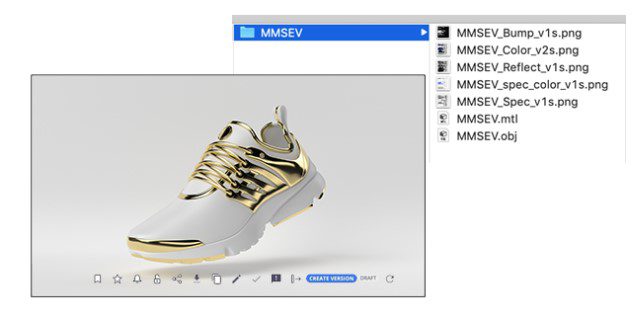The advantages of going 3D
More and more, product-oriented companies are making 3D assets a part of their core workflows. There are a number of important reasons for this:
- It is easier for designers to demo the initial concept (for example, to marketers, executives, focus groups, and other designers) if even the rough initial mockups are 3D and can be rotated, panned, and zoomed.
- The designer themselves can visualize things in 3D, such as space requirements; the best places to put things like screws, weld marks, or stitching; the visual impact of different material and feature options; and overall look and feel, that they wouldn’t necessarily see as easily in 2D.
- It reduces the need to create multiple 2D views. (And, in cases where those views are still needed, they can often be generated from the 3D model.)
- A 3D model can be virtually placed in a physical space. Even prior to prototyping a designer or marketer can use image editing software (or even augmented reality glasses) to create visuals for how a product could look in a home or a showroom. Customers are starting to use augmented reality apps to see how, for example, a piece of furniture might look in their homes.
- Some prototypes can be created using 3D printing. This can drastically improve the efficiency of the prototyping process. Even in cases where 3D printing cannot be used, the use of 3D assets can vastly improve communications with the people producing the prototype.
- Rotatable 3D product photos are becoming a key part of ecommerce experiences. Additionally, 3D models can be an important part of an end-user experience that allows customers to customize the product that they wish to buy.
The challenges
If 3D assets have not been a core part of a company’s workflows in the past but are set to become integral in the future, then the biggest challenge can be figuring out how to make those assets easily available to everyone who needs them, when they need them. Ideally, it’s not just the designers who know how to access the assets, but the production engineers, the marketers, the ecommerce developers, even the executives. In order to achieve that, the assets have to be part of a user-friendly workspace that people use naturally as part of their day-to-day work. Ideally, the 3D assets are linked to information about the material being used and other important metadata. And, hopefully, your product information system links to those assets. (We cover that more in this article in the section below about Product Asset Management.)
Using Nuxeo for 3D asset management
Managing 3D assets is different from managing more-typical digital assets (such as photographs). There are a couple of major reasons for this:
- A single 3D asset actually often consists of multiple files. For example, the textures are often contained in separate files than the shapes.
- There is a fairly wide range of standards and file types in place across various industries, and there can even be multiple standards in use within the same company.
- Creating previews (within an asset management system) can be complex because not all rendering services support all standards.
- Sharing the assets can be complex due to that use of multiple files.
- The value of 3D assets increases exponentially when they are linked, via metadata, to other relevant assets and information, such as materials, manufacturing specifications, and photographs.
Nuxeo has the ability to handle compound assets that consist of multiple files, and it is one of the few content service platforms that has a proven specialty in managing 3D assets. This includes rendering previews that users can rotate and pan in order to view the assets directly in the system.
Nuxeo is not an out-of-the-box solution – it consists of building blocks that are assembled in just the right way to fit with a client’s needs and business processes. This is a unique strength when it comes to 3D asset management. Because of the wide variety of uses and standards around 3D assets across the marketplace, it is important that a system be adaptable. For example, Nuxeo can be configured to work with various different rendering services to handle previews and conversions, depending on the client’s existing standards and their needs.
Finally, Nuxeo is a metadata-centric, API-first system that can be used for multiple purposes within a company and which is meant to integrate with a company’s existing systems. This makes it an ideal system for linking 3D assets with their materials in a materials library, with related photographs in a digital asset management system, and with all of their other product information.
Combining 3D asset management with overall Product Asset Management
Ideally, 3D asset management will eventually be a part of your overall product asset management system. Imagine managing the product design process in the same system where you have your materials library and where you track your finished products. Imagine being able to press a button and fill out a form to commission prototypes to be made based on a 3D design; or having your finished 3D designs accessible in the same place as your product photos. If your marketers have access to the final 3D assets, then those can be used for ecommerce alongside the photographs. If your designers eventually have access to all of your existing product assets alongside trends data in a single system, then that can help them to design new products to match those trends.
Taking a modularized approach
The idea of launching a new enterprise system can be daunting, especially if you’re considering a fully-integrated product asset management system. Modularization is key to success. This means building and launching immediately-useable smaller solutions that integrate with your existing IT investments and which are each part of a broad vision for product asset management. Each of these smaller solutions is ideally part of the same API-first platform.
So, for example, if 3D asset management is the priority, you could start by creating a place to host and preview 3D design files that also queries your existing supply chain management system to fetch and display data about the various materials that are slated to be used in each design. Once that is launched to end users, then you would build the next narrowly-scoped solution that interlinks with the first-for example, a user-friendly materials library that includes texture files, a form/workflow to request physical samples, and which links to the product designs that use the various materials, and which continues to ingest materials data from your existing supply chain management software.
Then we continue to build the additional interlinked solutions-for example, the library of existing products, the ability to send and receive data to and from your website or ecommerce outlets, photo studio workflows, digital asset management, and so on. At each stage, we make sure that each targeted solution serves a purpose as part of the integrated whole so that you are able to build a full Product Asset Management solution that is adapted to your business’s workflows while offering quick wins and efficiency gains at each step along the way.
Want more information?
iSoftStone has deep experience around Content Services Platforms. You can learn more about Nuxeo there and on Nuxeo’s own website. For more information and ideas around Product Asset Management, take a look at the article and video that we recently published on this subject.
Ready to start your Nuxeo journey? Or are you interested in learning about how iSoftStone can help you implement Nuxeo for your critical business needs? Please reach out!






